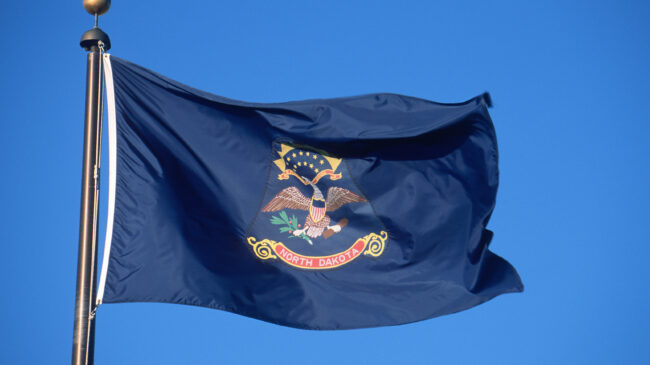Over the last 20 years, the North Dakota Public Employees Retirement System (NDPERS) defined benefit pension plan went from 115 percent funded with a surplus of $135 million to holding over $1.4 billion in unfunded actuarial liabilities. This significant growth in pension debt has promoted several legislative attempts at reform. The latest of these attempts, Senate Bill 2046, is currently being discussed in the state legislature. This analysis will measure the provisions within SB 2046 to better understand if the current reform proposal will achieve the goal of reducing liabilities, restoring plan solvency and protecting the integrity of NDPERS.
If implemented, SB 2046 would close North Dakota’s current defined benefit (DB) plan to most new state hires (with an exception for those in public safety and judges). The bill would allow political subdivisions to remain in the DB plan but become fully liable for the debt their hires generate.
SB 2046 will allocate legacy fund earnings to fund the transition to a full defined contribution (DC) plan and amortize DB plan debt. The bill seeks to achieve this with a one-time cash infusion of $100 million followed by subsequent payments of $40 million payments every two years until the NDPERS DB plan reaches 90 percent funding. If the plan again falls below 90 percent the biannual payments of $40 million will not start again until the plan’s fund ratio hits 70 percent.
The reform also allows for current DB plan members to opt into the DC plan, but the mechanisms to do so (via written election to the board) likely means that this provision would be rarely utilized.
The proposed plan design could reduce risk to the state by limiting the flow of new entrants into a structurally underfunded pension system. By directing new hires into a defined contribution plan the state effectively shifts risk away from taxpayers and eliminates the ability of these new hires to generate new pension debt.
However, to pay off current and future NDPERS debt a switch to a defined contribution plan should be paired with a viable funding strategy, which SB 2046 falls short of doing. While the bill stipulates a plan for additional funding, it is unlikely that these contributions will be enough to bring the system back to full funding under even the most optimistic of market return scenarios.
Working within data constraints and viewing the current NDPERS DB in its entirety as presented in actuarial reports, our preliminary modeling shows SB 2046 would increase unfunded NDPERS liabilities by $500 million dollars, drop the funding ratio to 0 percent and force the plan into a pay-as-you-go model within the 30-year modeling period assuming all other plan assumptions are met. This would imply that SB 2046 would have close to no chance of accomplishing the goal of ending the structural underfunding of NDPERS benefits, and it could make the debt substantially worse.
Likewise, the SB 2046 design for stopping the supplemental payments of $40 million at a 90 percent funded ratio may needlessly allow debt to linger. The trigger to restart payments at 70 percent funding could possibly allow debt to compile for years. Additional supplemental funding from the Legacy Fund should be viewed as a welcomed development, it is no substitute for adopting the actuarially required contribution as policy.
In short, SB 2046 would effectively create an end date for most current and future pension liabilities, but the impact of that change will take decades to make any noticeable impact on the system’s trajectory and risk levels. Given the current ambiguity over the bill provision to separate state and local debt within the fund, it is nearly impossible to know the full cost or date to which the debt will amortize for the state.
To drastically improve the chances of successfully paying down current debts and ensure full solvency of the DB plan while properly transitioning new hires to a defined contribution we recommend the following:
- Commit to pay the actuarially required contribution rate. This would guarantee that the state contributes at a level that fully funds all accrued retirement benefits regardless of market volatility.
- Amortize current NDPERS debt on a fixed schedule, ideally less than 30 years, to avoid runaway interest driving up unfunded liabilities and perpetuating intergenerational inequities;
- Amortize any future NDPERS DB debt in a given year on a closed schedule of 20 years or less schedule to ensure the legislature won’t need to address the issue again in the future; and
- Amortize unfunded liabilities for the legacy DB plan over total state payroll (legacy pension participants + new and existing defined contribution participants)—as Oklahoma, Arizona, Florida, Utah, and other states have done in similar situations—in order to ensure that legacy unfunded liabilities are paid down in a fiscally prudent manner.
- Lower the NDPERS assumed rate of return on investments gradually to 6.0 percent over a 10-year period to limit the system’s exposure to market volatility.
SB 2046 represents a good faith attempt to address the problem of runaway NDPERS pension debt. The Pension Integrity Project believes the efforts made by legislators, NDPERS members, and stakeholders are commendable. Be that as it may, if enacted as currently proposed, SB 2046 will likely require immediate follow-up legislation in future sessions to ensure the goals of improving NDPERS solvency and managing taxpayer risk fully materialize.
Full Scorecard for Senate Bill 2046
Stay in Touch with Our Pension Experts
Reason Foundation’s Pension Integrity Project has helped policymakers in states like Arizona, Colorado, Michigan, and Montana implement substantive pension reforms. Our monthly newsletter highlights the latest actuarial analysis and policy insights from our team.

